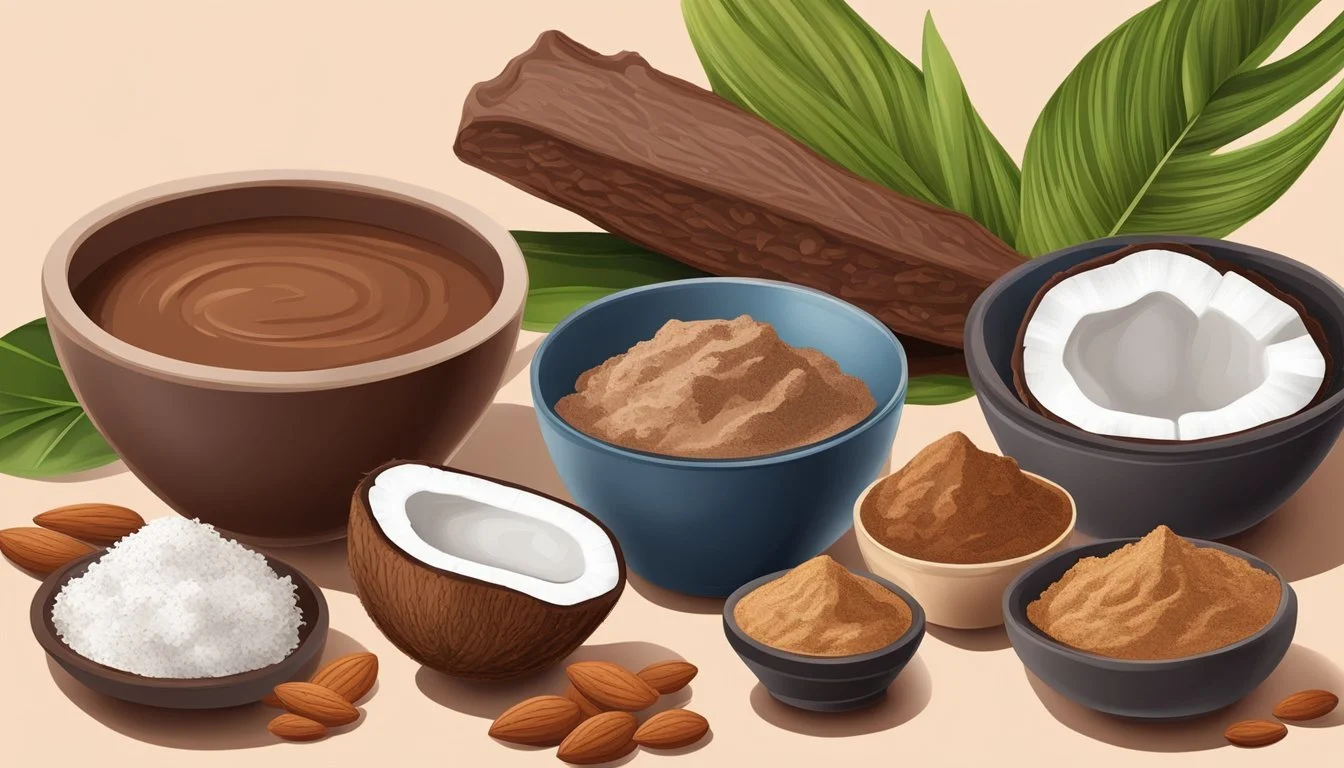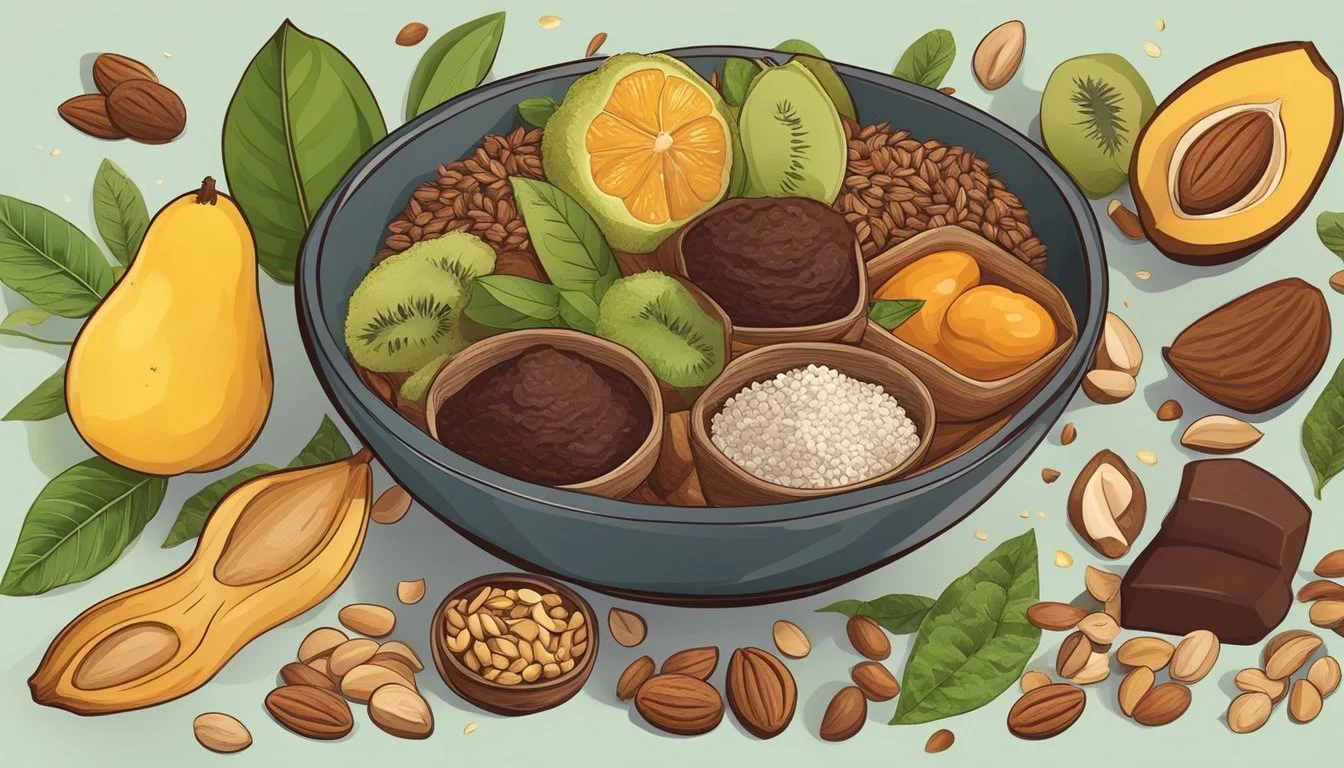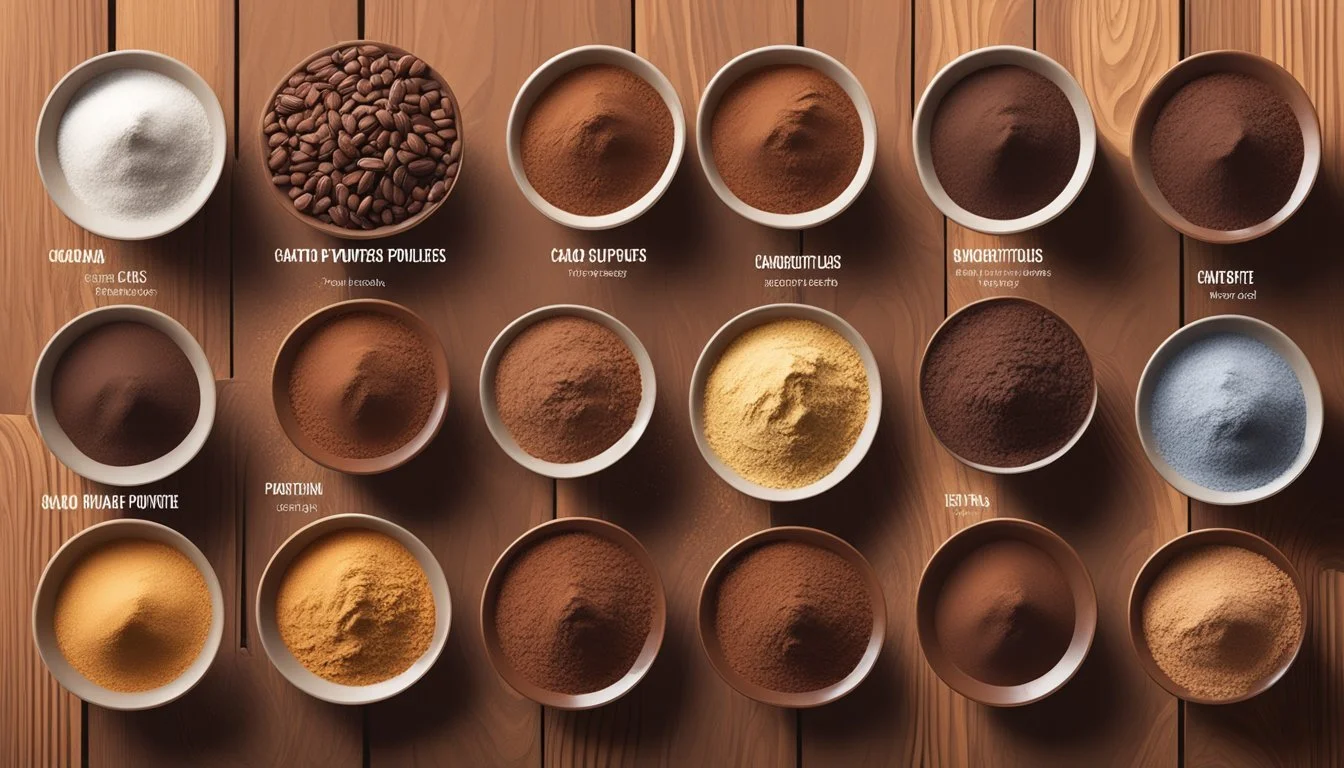Cacao Paste Substitutes
Best Alternatives for Baking and Cooking
Finding the perfect substitute for cacao paste can be a game-changer in your culinary adventures. For a natural cacao taste and aroma without the bitterness, consider using cacao paste itself, which consists of crushed and liquefied cacao beans solidified at room temperature due to high cocoa butter content. This makes it a versatile substitute for cacao powder in various recipes.
Another excellent alternative is baking or unsweetened chocolate, also known as chocolate liquor. With its 100% chocolate content, it offers a rich and authentic chocolate flavor, making it suitable for baking and cooking needs. Dark chocolate bars are another great choice, particularly when aiming for a deep, intense chocolate taste in desserts like brownies.
For those looking to replace cacao in a different form, carob powder provides a unique option. It works well in baking recipes such as cookies and cakes, and can also be used to create a smooth hot chocolate. Its slightly sweeter taste can offer a distinct flavor profile while still fulfilling the role of cacao paste in your culinary creations.
Understanding Cacao Paste
Cacao paste, also known as cocoa mass or cocoa liquor, is a fundamental ingredient in chocolate production. It is derived from cacao beans and offers numerous health benefits due to its natural composition.
Origin of Cacao Paste
Cacao paste originates from the seeds of the Theobroma cacao tree, often referred to as cacao beans. The cultivation process begins with harvesting these beans, followed by fermentation and drying. This preserves the rich, complex flavors and beneficial compounds.
The beans are then roasted and ground into a liquid, which solidifies into cacao paste when cooled. This paste is vital for crafting various chocolate products and holds historical significance in many cultures as a valued commodity.
Composition and Health Benefits
Cacao paste is rich in antioxidants, including polyphenols and theobromine. These compounds provide various health benefits. Polyphenols are known to improve heart health by promoting better blood flow and reducing inflammation.
Theobromine, a natural stimulant, contributes to a positive mood and enhanced energy levels. Because cacao paste retains the natural fat (cocoa butter) found in cacao beans, it also offers a creamy texture and a source of healthy fats.
Including cacao paste in the diet can support cardiovascular health and provide a rich, chocolatey flavor without the bitterness of processed cocoa products.
Cacao Paste in Culinary Applications
Cacao paste is versatile in various culinary creations, offering rich chocolate flavors in both cooking and dessert preparations. It enhances recipes with its intense taste and smooth texture, providing a natural and healthy alternative to processed chocolate.
Cooking and Baking with Cacao Paste
When used in cooking, cacao paste can elevate savory dishes with a hint of chocolate complexity. It pairs well with spicy ingredients, enhancing the flavor profile of mole sauces and other rich, savory sauces.
In baking, cacao paste serves as a foundation for chocolate cakes, brownies, and cookies. Its intense flavor and smooth texture provide a gourmet touch to baked goods. Blending cacao paste into batters and doughs introduces a deeper chocolate essence than traditional cocoa powder.
Cacao Paste in Desserts
Desserts benefit significantly from the rich, intense flavor of cacao paste. Chocolate confections, truffles, and pralines often use cacao paste for its luxurious texture and deep taste.
It's ideal for creating ganache for cakes and pastries, offering a robust chocolate flavor that complements various fillings and frosting. Sweet treats like chocolate mousse or puddings achieve a sophisticated taste with cacao paste, making them a favorite among chocolate enthusiasts.
Substitutes for Cacao Paste
When you need a substitute for cacao paste, several options are available that can replicate its rich chocolate flavor and texture. Here are some of the most effective substitutes you can use in various recipes.
Substitute Basics
Substituting cacao paste effectively involves considering both the flavor and texture it contributes to your recipes. Key substitutes include combinations like cacao powder with cocoa butter, or using natural cocoa powder paired with certain fats. Alternatives such as carob powder and even chocolate bars or chips can also be considered.
Cacao Powder and Cocoa Butter Combination
Combining cacao powder with cocoa butter mimics the consistency and flavor profile of cacao paste. To substitute, use a 1:1 ratio of cacao powder to cacao paste. Then, add a small amount of melted cocoa butter to provide the necessary fat content. This mix ensures that the substitute retains the deep chocolate flavor and smooth texture.
Natural Cocoa Powder and Fat
Natural cocoa powder with an added fat source can be another viable substitute. For each ounce of cacao paste, use ¾ ounce of natural cocoa powder and ¼ ounce of butter or oil. This combination is useful in baking recipes where maintaining the right texture is essential. Ensure the fat is well-incorporated to replicate the creaminess of cacao paste.
Carob Powder as a Substitute
Carob powder offers a caffeine-free alternative with a sweet flavor. Replace cacao paste by using the same amount of carob powder, though you may need to adjust sweeteners in your recipe. Carob naturally contains more sugar than cacao, so it’s ideal for recipes requiring less bitterness or for those who prefer a caffeine-free option.
Using Chocolate Bars and Chips
Chocolate bars or chocolate chips can serve as practical substitutes in many recipes. Choose dark chocolate with a high cocoa content for a closer match in flavor. For 1 ounce of cacao paste, use 1 ounce of chocolate, melted down. This method ensures the final product remains rich and smooth, similar to using cacao paste.
By utilizing these substitutes, you can achieve the desired chocolatey results without compromising on taste or texture.
Adjusting Recipes for Substitutes
When substituting cacao paste, various factors need to be considered to maintain the balance of the original recipe. Key aspects include fat content, acidity adjustments, and melting and texture considerations.
Importance of Fat Content
Fat content is crucial in baking, as it affects texture and moisture levels. Cacao paste is rich in cocoa butter, so when using alternatives like cocoa powder, adjustments in fat are necessary. Typically, for every cup of cacao paste replaced with cocoa powder, add 2-3 tablespoons of butter or a similar fat.
Example:
Substitute: Cocoa powder
Adjustment: Add additional butter
Without this additional fat, baked goods may turn out dry or crumbly.
Acidity and Flavor Adjustments
Cacao paste has a natural acidity which can affect the leavening agents such as baking soda and baking powder. When switching to substitutes with different acidity levels, such as dark chocolate or carob powder, alterations may be needed.
If the substitute is less acidic, increasing the amount of baking powder, which requires acid to activate, may be essential. Conversely, add a touch of baking soda if using a more acidic alternative.
Example:
Substitute: Carob powder
Adjustment: Modify the quantity of baking powder or add baking soda
This ensures proper rise and texture.
Melting and Texture Considerations
Different substitutes melt and integrate with other ingredients in unique ways. For instance, dark chocolate bars melt at a different rate compared to cacao paste.
To replicate the creaminess of melted cacao paste, chop substitutes like dark chocolate finely before melting. Mixing melted substitutes thoroughly with other ingredients ensures consistency.
Example:
Substitute: Dark chocolate
Preparation: Chop finely before melting
This method helps maintain a smooth, cohesive texture in the final baked product.
By considering these factors, one can effectively substitute cacao paste while maintaining the quality and integrity of the recipe.
Health and Nutrition Factors
Choosing a substitute for cacao paste impacts both health and nutrition. Each alternative has unique caloric values, nutrients, and potential health effects.
Caloric and Nutritional Content
Different substitutes for cacao paste vary significantly in their nutritional profiles. Cacao powder and carob powder are often used due to their health benefits. Cacao powder provides high levels of antioxidants, magnesium, and iron but contains caffeine and theobromine. Carob powder, on the other hand, is caffeine-free, lower in calories, and rich in calcium and fiber.
Unsweetened baking chocolate and dark chocolate bars are higher in calories and fats compared to cacao powder. They contain significant amounts of cocoa butter, which increases their fat content. It's essential to consider the nutritional differences; a higher fat and calorie content can affect overall calorie intake if used frequently.
Effects of Substitutes on Health
The health effects of cacao paste substitutes vary greatly. Cacao powder has the benefits of naturally occurring compounds like flavonoids that support heart health and improve cognitive function. However, its caffeine and theobromine content can affect individuals sensitive to these stimulants.
Carob powder is a healthy alternative for those avoiding caffeine and theobromine. It promotes digestive health due to its fiber content and provides minerals like calcium which are beneficial for bone health.
Unsweetened baking chocolate and dark chocolate have antioxidants, but their higher fat content necessitates moderation in consumption. Overconsumption can lead to weight gain and associated health issues. Each substitute offers distinct benefits and drawbacks, making it important to choose based on specific health and dietary needs.
Types of Cocoa Powders
Cocoa powders are essential in baking and cooking, offering unique flavors and functionalities. They are primarily categorized as natural cocoa powder and Dutch-processed cocoa powder, each with distinct characteristics.
Natural vs. Dutch-Processed
Natural Cocoa Powder: Natural cocoa powder is made from cocoa beans that are simply roasted and ground. It has a strong, concentrated chocolate flavor and a lighter color. Because it is acidic, it reacts with baking soda to produce leavening in recipes. Natural cocoa powder is commonly used in recipes where a rich chocolate taste is desired without additional fat.
Dutch-Processed Cocoa Powder: Dutch-processed cocoa powder, also known as alkalized cocoa powder, is treated with an alkaline solution to neutralize its acidity. This process gives it a darker color and a milder flavor compared to natural cocoa powder. It doesn't react with baking soda, so it is often used with baking powder in recipes. This type of cocoa powder is ideal for recipes requiring a more subdued chocolate flavor and a smooth texture.
Both types of cocoa powders bring unique qualities to recipes and understanding their differences can significantly impact the taste and texture of your baked goods.
Alternative Substitution Options
When looking for substitutes for cacao paste, it's important to consider both non-chocolate alternatives and plant-based, vegan-friendly options. Each substitute brings unique flavors and characteristics to food preparations.
Non-Chocolate Alternatives
In some recipes, avoiding chocolate altogether may be desired:
Carob Powder: Carob powder is a popular non-chocolate substitute, perfect for those avoiding caffeine. It has a naturally sweet taste, which means you might adjust sugar levels in recipes.
Malted Milk Powder: This can be used in some desserts, offering a slightly sweet and creamy flavor. Ideal for recipes that can benefit from a malty note.
Plant-Based and Vegan Substitutes
Those seeking vegan substitutes have several options:
Unsweetened Baking Chocolate: This is ideal for recipes requiring a deep chocolate flavor. Ensure it’s vegan-friendly by checking the ingredient list for dairy additives.
Dark Chocolate Bar: Choose dark chocolate with at least 70% cocoa content for a richer flavor. Melt and use in place of cacao paste, adjusting for sweetness as needed.
These options ensure that both dietary restrictions and flavor preferences can be accommodated in various recipes.
Creating Your Own Cacao Paste
Making cacao paste at home is a rewarding process that gives you control over ingredients and quality. In this section, learn effective DIY methods and how to store your homemade substitutes.
DIY Methods
To create cacao paste, start with high-quality cacao nibs. Grind the nibs in short bursts to avoid overheating. Aim for a fine powder or a smooth paste, depending on your preference. This usually takes 5-10 minutes, and using a powerful food processor or a specialized grinder ensures optimum results.
Another method involves melting cacao butter and mixing it with cacao powder. Heat cacao butter gently in a double boiler, ensuring water in the lower pot doesn't touch the upper vessel. Once melted, stir in the cacao powder until smooth.
Storing Homemade Substitutes
Proper storage is essential to maintain the flavor and quality of your homemade cacao paste. Store it in an airtight glass container to prevent moisture absorption and exposure to air. Keep it in a cool, dark place, such as a pantry, to avoid heat and light degradation.
For longer storage, refrigerate or freeze the paste. If frozen, allow it to come to room temperature before using, to restore its texture and flavor. Properly stored, homemade cacao paste can last several months, ensuring you have a fresh supply for your culinary needs.







